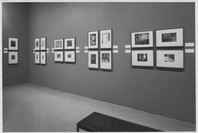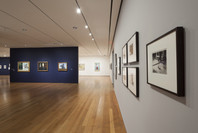A solitary figure hurries down an empty city street in this dramatic composition, a view from above. Hopper made this and other etchings early in his career, before turning exclusively to painting and drawing in 1928. Etching, a technique in which a composition is incised into a metal plate and then printed in ink on paper, was particularly suited to Hopper's style, allowing him to use strong, clean lines and cross-hatching to enhance the mystery of his chosen subject—here, the empty city at night.
Gallery label from American Modern: Hopper to O'Keeffe, August 17, 2013–January 26, 2014 .
While a student at the New York School of Art, Edward Hopper studied with Ash Can painter Robert Henri, who favored harsh scenes of city life and whose circle included printmakers John Sloan and George Bellows. Hopper had also been to France, where he admired the etchings of Édouard Manet, Edgar Degas, and Charles Meryon. Initially a commercial illustrator, Hopper contributed to the Socialist magazine The New Masses, when his friend, the masterful etcher Sloan, was art editor there from 1910 to 1914. The following year, with the help of the artist Martin Lewis, Hopper began making prints. Between 1915 and 1928 he made seventy etchings and drypoints before turning exclusively to painting. During those formative years, intaglio prints earned Hopper recognition as well as sales, and he bought his own press so that he could experiment in his studio and print as the demand arose.
The subjects most identified with Hopper are empty settings—an isolated house, a vacant room, an abandoned street. Mystery and psychological tension are evoked through the manipulation of light, unusual vantage points, and dramatically simplified compositions. When figures are included, they are often alone, engulfed in a sense of solitude or dwarfed by their physical environment.
Hopper also depicted trains, such as The Locomotive, which monumentalizes the steam engine while literally marginalizing and cutting off one figure standing at the left. The brightly lit overpass and darkened tunnel ahead exemplify Hopper's symbolic use of light and architecture. In Night Shadows, the view of a lone figure from a high vantage point adds an atmosphere of suspense. Both prints demonstrate the vigorous cross-hatching, deeply bitten lines, and heavy inking that are typical of Hopper's etchings. The starkly white paper he specifically sought out, and the manner in which he wiped the ink on the copperplates, also contribute to the intensity of his chiaroscuro effects.
Publication excerpt from an essay by Jennifer Roberts, in Deborah Wye, Artists and Prints: Masterworks from The Museum of Modern Art, New York: The Museum of Modern Art, 2004, p. 117.





